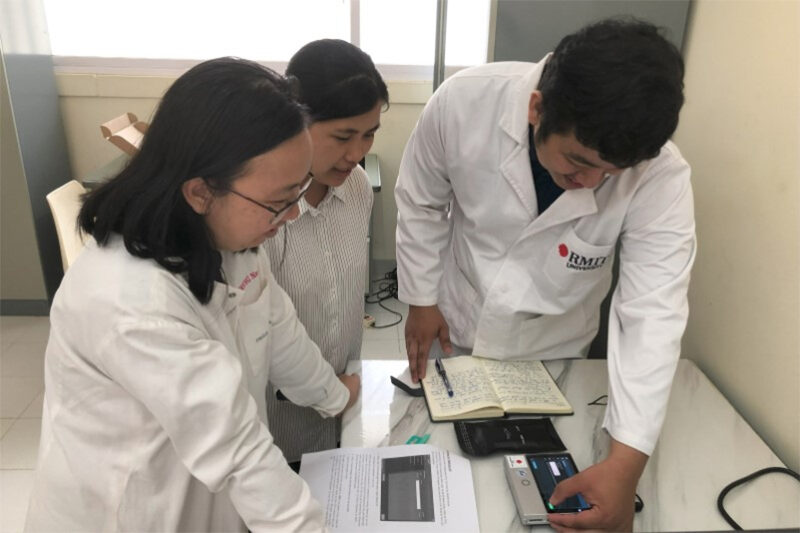
Foodborne pathogens, such as E. coli and Salmonella, are a significant source of intestinal illness in Cambodia. Identifying where they enter the vegetable supply chain — on farms, during transport, at distribution centers or in markets — is key information for developing strategies to strengthen food safety. A recent training has equipped Cambodian researchers at three institutions in a cutting-edge genomic technique to bolster pathogen tracking and reduce foodborne illness.
The week-long virtual workshop provided by scientists at The Pennsylvania State University (Penn State) focused on whole genome sequencing (WGS) of bacteria. Because WGS can be used to distinguish among closely related strains, researchers can pinpoint precisely where contamination with foodborne pathogens is occurring in the supply chain. Fifteen students and researchers from four institutions participated in the training, including the Institut Pasteur du Cambodge, the Institute of Technology of Cambodia and the Royal University of Agriculture. The workshop is part of a project funded by the Feed the Future Innovation Lab for Food Safety to reduce the prevalence of foodborne pathogens in fresh produce in Cambodia.
“Currently, our lab provides food safety testing, and we have expertise on normal test method standards for bacteria, but not on molecular biology of those bacteria,” says Navin Sreng, head of Laboratory of Environment and Food Safety at the Institut Pasteur du Cambodge and project co-principal investigator (PI). “Therefore, this WGS training is very important for us in order to develop the research abilities of the lab.”
Traditionally, scientists have used microbiology tools to detect foodborne pathogens in foods and food processing environments. They include swabbing surfaces to collect bacteria and growing them on special plates until visible colonies form. While those methods can be used to identify the species present, WGS adds precision. WGS can be used to tell if the specific strain found in a market is highly similar or identical to a strain present at a different point in the supply chain, such as the farm. The detailed information provided by WGS is valuable for tracking down sources of contamination and outbreaks.
“By using whole genome sequences, we get a lot more information, and we use that information to infer or make some assumptions as to how that pathogen has been moving through the supply chain,” says project co-PI Jasna Kovac, the Lester Earl and Veronica Casida Career Development Professor of Food Safety at Penn State’s Department of Food Science. “Whole genome sequencing really helps us identify precisely what the major sources of contamination are and where pathogens are entering the food supply chain.”
Kovac uses the analogy of a fingerprint. “Each individual has a unique DNA fingerprint, so by finding an identical fingerprint in two locations, we can infer that that individual was present at those two locations,” she says. “And once we have that information, we can develop more targeted and more effective contamination mitigation strategies. Instead of trying to implement control strategies at all points of the supply chain, we can really focus on the one that is likely going to be most impactful.”
Initially, the plan was for bacteria samples collected in Cambodian farms, distribution centers and markets to be sequenced and analyzed only at Penn State. Kovac and project co-lead PI Jessie Vipham, associate professor in food safety and food security at Kansas State University, pivoted to teaching their collaborators in Cambodia how to perform WGS using a portable nanopore sequencer and how to analyze sequences to construct a complete genome for each bacterial isolate and compare genomes of isolates across samples. Taejung Chung, a Ph.D. candidate at Penn State, and Xiaoyuan Wei, a postdoctoral scholar, developed the trainings as well as online materials that the team can access at any time for future use.
“We provided the equipment, we shipped everything the teams needed in Cambodia from the U.S., and also provided them with videos that demonstrated step-by-step procedures on how to do DNA extraction and sequencing,” says Kovac.
Once the Cambodia researchers had collected their data, they processed it during the week-long WGS analysis workshop. The data is complex: The Salmonella genome has about five million base pairs encoding some 4,000 genes, and researchers must assemble sequences of DNA to construct whole genomes, and then compare the genomes of different isolates. The genomic analysis can provide information about whether a pathogen carries any antimicrobial resistance genes, which could compromise treatments of infections using antibiotics or that might help them survive the sanitizers or disinfectants that are used in food processing environments.
“Whole-genome sequencing is a rapid and accurate method to detect potential foodborne pathogens along the food supply chain, ensuring food safety,” says co-PI Chanthol Peng, a lecturer and researcher of the Faculty of Chemical and Food Engineering, Food Technology, and Nutrition Research Unit at the Institute of Technology of Cambodia. “The training has expanded my abilities, and I’ll use that knowledge to aid in improving local food safety. The added level of precision in the surveillance of pathogens will lead to faster and more efficient decision-making in the preparedness and response to foodborne outbreaks.”
Christina Frank is a freelance writer with the Feed the Future Innovation Lab for Food Safety.

